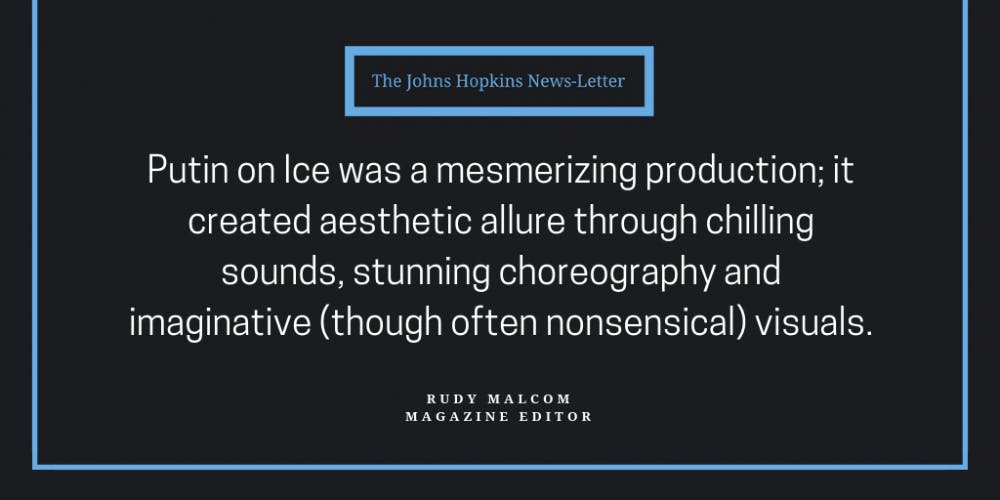When I first heard about Putin On Ice (that isn’t the real title of the show), I was instantly intrigued. The self-described “fantastical new portrait of Vladimir Putin” — co-created by Single Carrot Theatre (SCT) and the Acme Corporation — promised to be “something entirely new and thrillingly strange.” Indeed it was, even before I stepped into the theater. At the door, someone wearing a black executioner mask ushered audience members one-by-one into a dark chamber. “You are free to leave at any time,” they said.
This sentence was repeated an innumerable number of times throughout the performance. Spectators flanked two sides of the stage, which comprised three aligned tables surrounded by chairs. Both of the other sides had projection screens, and one of them had a guitar, piano and marble bust of Putin framed by two crimson drop-banners. These banners, though reminiscent of those of Nazi Germany, depicted not swastikas but outlines of televisions.
The show begins with director Yury Urnov’s wife Tania Karpekina (who plays herself) zooming in on a photograph of Putin’s face on an iPad. Next the rest of the cast members march around the stage, highlighting their beautifully designed costumes (Shoutout to Molly Cohen!) and each portraying a different propagandistic or media representation of Putin: Baby Putin (Cohen), Hockey Putin (Paul Diem), Judo Putin (Alix Fenhagen), Military Putin (Sophie Hinderberger), Putin with the Animals (Ben Kleymeyer), Putin with the Birds Separately (Meghan Stanton), Party Putin (Matthew Shea), Religious Putin (Mohammad R. Suaidi) and Drag Putin (Kaya Vision).
They apologize in advance for the “jarring nature of the performance” and display hilarious memes and videos of Putin, as well as a slideshow of digitally edited pictures that render his likeness in portraits like the Mona Lisa, paintings by Jan van Eyck (honestly, those might not have been photoshopped) and other disturbingly colorful images.
They explain that Putin is both “already coming” and “already here,” that “the more you look, the more he can be found” throughout global literature, history and culture. Making excellent use of the mobile set, they reenact the most famous scenes from Romeo and Juliet and Hamlet and demonstrate the Russian president’s manipulative and clandestine presence in Shakespearean theater.
By means of toy houses and cars, dolls and string, they accuse him of assassinating Archduke Franz Ferdinand of Austria and thereby catalyzing the First World War. Moreover they allege that Putin is the pain your doctor can’t explain or fix. He’s a “non-corporeal entity that transcends time and space.” A tasteless, colorless, radioactive, chemical element always increasing in abundance — unstoppable.
The play ends with an interactive game show of sorts (“Name that Putin!”), followed by a musical number and every actor whispering not quite in unison “You are free to leave at any time,” over and over.
Putin on Ice was a mesmerizing production; it created aesthetic allure through chilling sounds, stunning choreography and imaginative (though often nonsensical) visuals. But it was also a sensory overload that makes recounting its contents difficult.
Trying to recall specific details and lines feels a bit like trying to narrate a night after browning out. Playwright Lola B. Pierson explained to the Baltimore Fishbowl that she was interested in using theater to mirror how we are inundated with sensationalized news through the internet and social media. I commend her desire to imitate life through art, but I think its execution was ineffective.
Furthermore, the play was rather confusing; I wondered why it didn’t mention Russian interference in the 2016 U.S. presidential election. The show left me with several questions: Was it trying to suggest that believing that Putin is a big deal is ridiculous, that we shouldn’t blame him for problems in the U.S. (like slavery, which Drag Putinrgb makes a point of attributing to “greed and dehumanization”)?
Was it trying to mock the media for providing Putin with excessive and empowering coverage? Is this why the versions of Putin are self-defeatingly exposing themselves? Has Putin become larger than life because journalists have inadvertently become his aggrandizers while striving to condemn his influence?
Do we, despite knowing well that we “are free to leave at any time,” consume such dangerous media willingly?
While I didn’t expect to leave SCT thinking that the President of Russia is an all-powerful deity, I would’ve enjoyed the play much more if its cast had championed more specific and better developed conspiracy theories.
You could probably convince me for a few seconds that the first Moon landing was faked; it is indeed peculiar that a flag planted on the Moon seemed to flap without air. (In reality, a flag can flap in a vacuum because of inertia.)
You could probably convince me for even longer that the government killed Marilyn Monroe or that eating avocado has brainwashed us into accepting a New World Order (read: Antoni from Queer Eye is the Illuminati, change my fucking mind).
But Putin On Ice failed to offer any reasoning to back its conspiracy theories, which weren’t even funny beyond their downright preposterousness.
The show — and whatever its message may have been — failed to appeal to me on an intellectual level.
Yet Urnov and Pierson told Fishbowl that they aspired to transcend satire in order to “create a hyper-real impression of the way Putin as an idea manifests in our chaotic political culture.”
Pierson emphasized how important it was for Putin On Ice not to “devolve into some sort of intellectual discussion” about Putin and Donald Trump’s relationship. Both sought not to critique the controversial politician but to instead invoke absurdism and evoke emotion. Urnov compared Putin to a “balloon that absorbs all attention, negative or positive.” He hopes that the show fills the balloon with enough air for the balloon to finally pop.
You might just have to decide for yourself whether Urnov and Pierson’s reasoning comprises a half-baked excuse for deficiency or conveys brilliant and revolutionary intention. Putin On Ice runs at SCT until Oct. 7.





